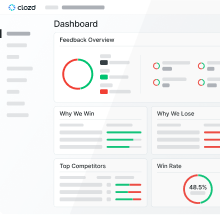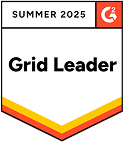
Good question design is a crucial ingredient to any successful win-loss analysis program. In this post, we explore basic principles for conducting effective win-loss interviews, the best win-loss analysis question design methodology, and sample questions to help you get started.
When executed well, a win-loss analysis interview is the ideal method for determining why you won or lost a specific sales opportunity. As you track insights across a large sample of interviews, you’ll uncover specific ways to improve your solution and win more.

For a free, comprehensive guide to win-loss analysis click here.
Principle 1: Start with broad, open-ended questions to let the buyer tell their story.
Every buyer’s use case and evaluation experience is unique in some way. For that reason, you should start your buyer interview with broad, open-ended questions that encourage them to tell their unique story. This general context should then influence the nature and order of interview questions you ask during the rest of the conversation.
Consider starting your win-loss interview with questions like:
- What prompted you to evaluate ________ solutions at this time?
- How did you first learn about _________?
- How did you structure and run your evaluation?
- What was your final decision?
- Why was that the right decision for your business?
Principle 2: Determine core topics and questions to cover in every interview.
Next, you’ll want to leverage the momentum and learnings from the introductory questions to dive deeper. Determine several core topic areas that you wish to probe about (i.e., solution requirements, pricing, competitive landscape, sales experience, etc.). Develop a few open-ended questions for each topic area. Here are some common examples of topic areas and win-loss interview questions:
Product or Solution
- What specific requirements did the product/solution need to meet?
- Which capabilities were most important to you?
- What were your impressions of ________’s product/solution?
- What were its most significant strengths? Weaknesses?
Sales Experience
- What was it like working with ________’s sales team?
- What did they do well? Poorly?
- How did the experience compare to working with other vendors?
- How did the sales experience impact your final decision?
Pricing & Packaging
- How did you react to ________’s initial pricing quote/proposal?
- How did ________’s price compare to that of other vendors?
- Did ________’s pricing model align with your needs and expectations?
- What methods did you use to determine the value or potential ROI of a solution like this?
Competitive Landscape
- What other vendors did you include in your evaluation?
- In what ways did _______ excel in comparison to the other vendors?
- In what ways did _______ fall short compared to the other vendors?
- Win: Which vendor offered the strongest alternative?
- Loss: Which vendor did you choose? Why?
Principle 3: Formulate additional drill-down questions for specific scenarios.
To ensure success, spend time preparing additional win-loss questions that will help you dig deeper in specific scenarios. For example, if your company sells marketing software, you have probably seen how vital the software’s ability to integrate with other platforms is to some buyers. You should develop targeted questions to ask whenever a buyer mentions integrations as a critical feature in their decision. Avoid asking a question like, “Are integrations important to you?” Instead, ask an open-ended question like, “What are the most important integrations to you and why?”
Principle 4: Avoid closed-ended questions.
Throughout the interview, make sure that the majority of your questions are open-ended. Our favorite win-loss interview questions are what and why questions. They tend to introduce less bias and keep the interview conversational. Avoid asking quantitative, scale-based questions (i.e., On a scale of 1-5, how helpful was our sales team?). These questions are time-consuming because they require lengthy explanations to clarify the rating scale, and interviewees get confused easily. Quantitative questions also distract from the ultimate goal of hearing the buyer’s full story. Preserve as much time as possible for qualitative discovery. If there are quantitative questions that you need to ask, for trending or benchmarking purposes, ask them after the interview using a short survey.
Principle 5: Adapt on the fly.
The most important principle for an effective win-loss interview is adaptation. As you listen to the unique story of each buyer, adapt your questions according to their responses. Skip irrelevant topics and questions. Spend extra time probing in areas that were particularly influential for them. Go out of order. An effective win-loss interview is conversational and adaptive. Avoid conducting a rigid, survey-like interview. Simply put, have a conversation that reveals the real reason you won or lost the deal.
For example, if an interviewee mentions a specific product gap that influenced their decision, pivot to questions about that product capability. Ask more in-depth follow-up questions, right then, to uncover why that capability was necessary for their use case and what the ideal solution would offer.

During each interview, listen actively to the buyer’s story and then adapt your line of questioning.
As one last tip, we suggest not doing your first win-loss interview with an actual buyer. It may help to do a couple of practice sessions with people internally that have a good sense of how a buyer might answer some of your questions.
For more information about win-loss analysis, explore these additional resources:
Clozd’s Definitive Guide to Win-Loss Analysis
Webinar: How to Conduct an Effective Win-Loss Interview
Win-Loss Analysis Learning Center











.svg)




.png)





.svg)

.svg)




